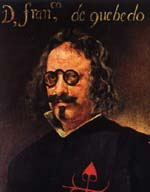
(1580-1645)
Francisco de Quevedo y
Villegas
(1580-1645)
1580 Born in Madrid. Parents, Pedro Gómez de Quevedo and María de Santibáñez, hold positions in the Court. Quevedo is the third of six siblings. Suffers physical deformities in his feet and of myopia that makes it necessary for him to wear glassses.
1586 Death of father. Mother dies in 1600.
1596 Begins his studies in the University of Alcalá de Henares. Three years later receives Bacheor's degree, and in 1600, that of licenciado and begins studies in Theology. Frinedship with Pedro Téllez Girón, the future Duke of Osuna.
1602 Quevedo begins to make his name as a man of letters. Some of his poem appear in Flores de poetas ilustres of Pedro de Espinosa.
1603 to 1608 Writes El buscón.
1605 Travels to Madrid, and around 1609, suffers a spiritual crisis. Seeks refuge in La Torre de Juan Abad (Ciudad Real).
1606 Returns to the court in Madrid, where he possibly receives minor religious orders and is integrated into the literary life of the court.
1609 Writes España defendida. Begins his suit for ownership of La Torre de Juan Abad.
1610 Is denied permission to publish his Sueño del juicio final.
1613 Travels to Palermo to serve the Duke of Osuna, Viceroyal of Sicily during the years 1610 and 1616.
1617 Diplomatic mission to Rome. After, travels to Madrid to care for the interests of the Duke of Osuna. Felipe III awards him the habit of the Knights of Santiago.
1618 Political decline of the Duke of Osuna. Quevedo returns from Naples.
1621 Felipe III dies and is succeeded by Felipe IV. Proceedings against Pedro Téllez Girón, that involves Quevedo. Is made Lord of the Torre de Juan Abad, the villa to which he had been exiled before the change of reign. Jailed briefly in Uclés. Suffes a new exile as a consequence of the judicial proceedings against his former protector. In his Grandes anales de quince días he narrates the confusion that reigned during the weks folowing the death of Felipe III.
1624 Travels with the court to Andalucia. The Duke of Osuna dies in prison.
1626 His works Política de Dios and El Buscón appear in print without his authorization.
1628 Exiled to the Torre de Juan Abad for about a year due to his defense of Santiago as only patron saint of Spain. Some of his books censured by the Inquisition.
1629 Writes El chitón de las tarabillas, (anonymously) in support of the politics of the Count-Duke Olivares.
1631 After trouble with the Inquisition there is a proliferation of pirated editions of his works. Publishes Juguetes de la niñez, a work that gathers new texts as well as others of a burlesque or satirical nature, now revised. Editions of the poetic works of Fray Luis de León and of Francisco de la Torre, dedicated to the Count Olivares (edited in 1629).
1633 Produces his Execración contra los judíos, a work that reveals his profound antisemitism.
1634 Marries Esperanza Mendoza, señora de Cetina but they separate a few months later. given the post of Secretario del Rey. Publishes La cuna y la sepultura y la traducción de La introducción a la vida devota de Francisco de Sales. Period of literary activity. Betweeen 1633 and 1635: De los remedios de cualquier fortuna, the Epicteto, Virtud militante, Las cuatro fantasmas, the second part of his Política de Dios, the Visita y anatomía de la cabeza del cardenal Richelieu or the Carta a Luis XIII.
1639 December 7th is arrested in Madrid in the house of the Duke of Medinaceli and imprisoned in San Marcos de Leon; where he is imprisoned until June of 1643, five months after the fall of the Count of Olivares. Writes his works La Rebelión de Barcelona and the Providencia de Dios.
1644 In November, and with his health deteriorating, he retires to La Torre de Juan Abad. Publishes Marco Bruto and La caída para levantarse and prepares an edition of his poetry, that will appear posthumously in 1648.
1645 Dies in Villanueva de los Infantes.
Passage from http://coloquio.com/famosos/quevedo.html
"More than a writer, Quevedo was a vast literature unto himself", said Jorge Luis Borges of this great writer of Spain's Golden Age century. He was a novelist, satirist, diplomat, court wit and a great poet. Few writers can match him in bending the Spanish language to astonishing feats of lexical originality. A master of the grotesque, he refined it in his works Los Sueños (Visions) and La Vida del Buscón, the latter a picaresque novel. He is also author of philosophical treatises, political essays and reams of poetry covering every possible range of mood. His influence has been felt by the greatest modern Spanish poets and allusive lines pointing to him can be found in Pablo Neruda, Miguel de Unamuno and many others.
A un hombre de gran nariz
era un reloj de sol mal encarado,
érase un elefante boca arriba,
érase una nariz sayón y escriba,
un Ovidio Nasón mal narigado.
Erase el espolón de una galera,
érase una pirámide de Egito,
las doce tribus de narices era;
érase un naricísimo infinito
frisón archinariz, caratulera,
sabañón garrafal, morado y frito.
Otra versión (posiblemente la original)
del terceto final:
érase un naricísimo infinito,
muchísimo nariz, nariz tan fiera,
que en la cara de Anás fuera delito.
To a man with a big nose
it was a sundial doomed to face the shade,
an elephant that looked up to the sky,
it was a nose of hangman and of scribe,
Ovidius Naso nostrilled all awry,
it was the bowsprit of a mighty ship,
like Egypt's pyramid it pierced the sky,
it was of noses all of the twelve tribes;
it was in noseness truly infinite,
an archnose shudder, and a frightening mask,
a monstrous chilblain, purpley and fried.
|
Translation of the alternate final tercet
(©Alix Ingber, 1995) |
Poems from: http://sonnets.spanish.sbc.edu/